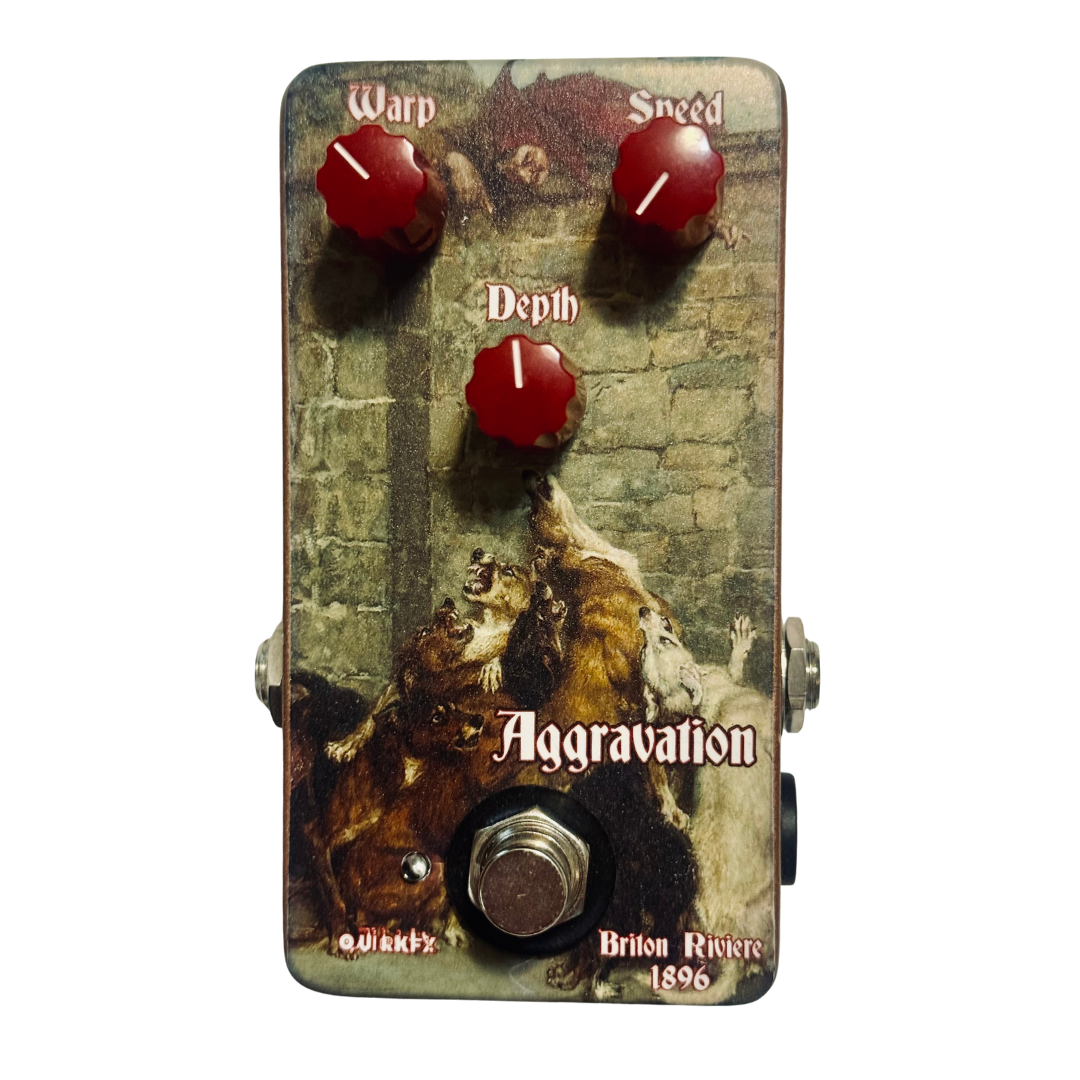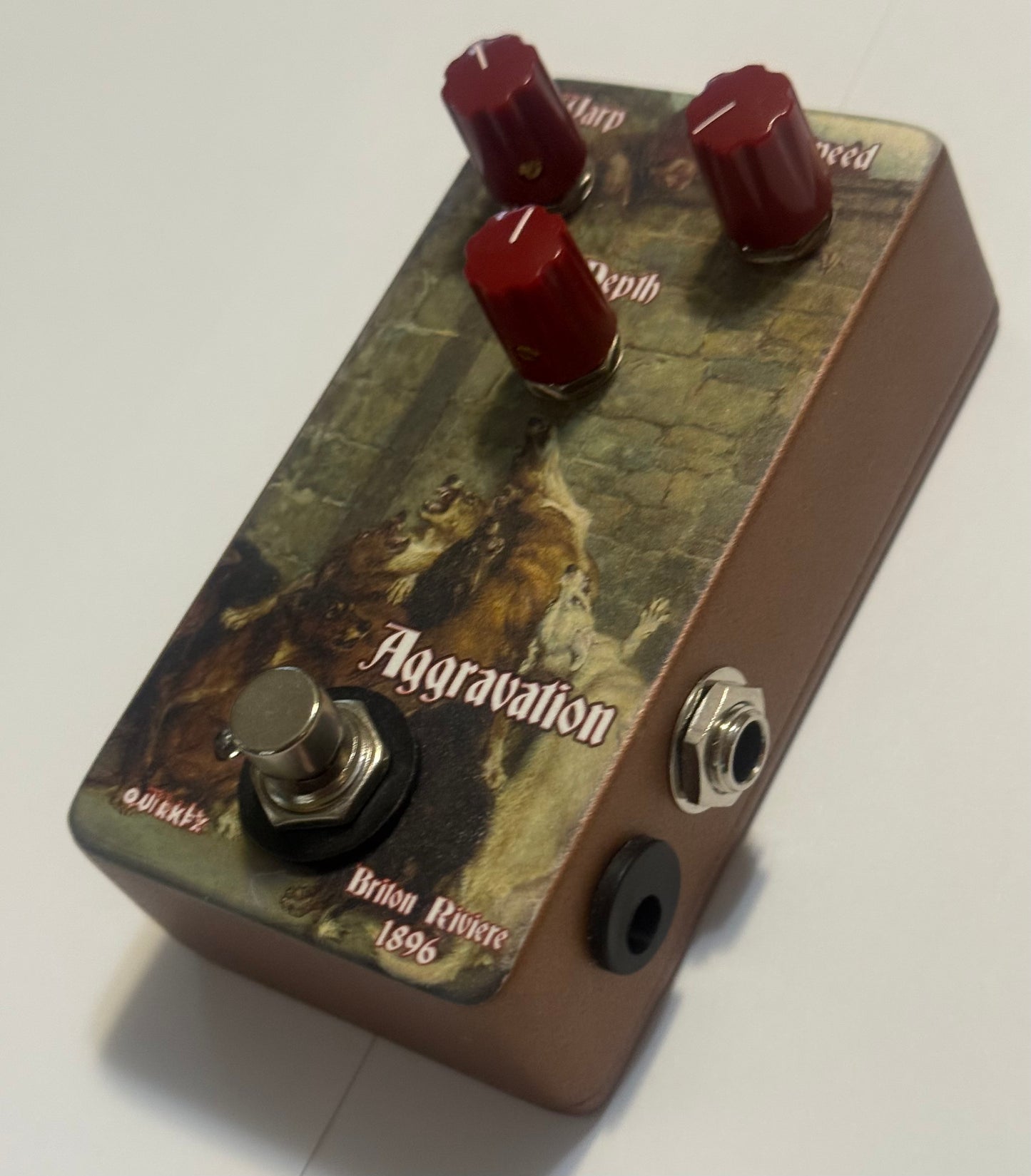Aggravation
Aggravation
by Quirkfx – View all from this builder
📦 Ships instantly from our US warehouse in Ohio.
🔥 One-Off Alert!
Jason at QuirkFX only makes one of each pedal — ever. This is the ONLY one in existence, and once it’s gone, it’s gone for good.
Vibrato? Kinda. Weird, wacky, wonderful warping.... yeah. More like that.
Based on the Seppuku Mind Warp
The Mind Warp is an extremely variable vibrato effect, but it gets pretty weird. With the LFO Speed turned back you can achieve very slow dreamy modulation all the way to over the top weirdness when turned up. The depth knob allows you to control how far the pitch shifts. it can be set to be very faint, or as weird and out of tune as you'll ever need, far beyond the range of conventional vibrato effects. The warp knob allows you mix your clean signal with the modulated signal to create chorus effects.
This circuit is built around a PT2399 IC, pretty standard for lots of modern modulation and delay circuits. But this is NOT meant to sound like a CE-2 or Small Clone. It’s meant to be weird, different and unpredictable. My favorite circuits to make and play!
Controls
Use a standard 9V power supply, Center negative
•
Warp - where the magic is, although it’s quite simple in theory. This blends in your clean signal with the modulated effect, making the output LESS weird as you turn it to the right.
Speed - Good range of speeds, from ambient swoosh to all-out warbling.
Depth - how far the modulation shifts from the original pitch. Left/Counterclockwise is subtle, turn to the right for deeper pitch shifts and wacky warbling.
Note: The warp may seem “backwards” at first, until you remember that it’s your clean signal. More clean is less weird, right? To figure out the full capability of this thing, I’d start with the Warp all the way “up” and just play with Speed/Depth. Find your way through some more subtle sounds (not really a traditional chorus, but in that ballpark). Then turn the warp down to figure out how far out there this thing can go.
Build/Design Notes:
Chorus as an effect has it roots in Vibrato (a related modulation) and the Leslie rotating speakers that added a special something to Hammond organs as far back as 1935. But it wasn’t until 1975 when the Roland Jazz Chorus (JC-120) amplifier made the sound readily available to guitarists. Boss released the first chorus pedal, the CE-1, in 1976 (still a classic, tho rare as unicorn shite). Electro-Harmonix followed with the Clone Theory in 1977 and the Small Clone in 1979, the same year Boss released the CE-2. So 1979 was the year that birthed the top two “old school” analog classics.
Chorus works by making a copy of your signal and then changing the pitch of that copy, playing it in tandem with your original, unaffected signal. This doubles the sound while thickening it through the periodic variations in pitch. Take out the dry signal and up the Depth (and for this circuit, the time as well) and you’ve got a version of a vibe. Old-school Chorus circuits were built around BBD (“Bucket Brigade”) chips to modulate Speed and Depth (same foundation as a Delay). These days both delays and modulations often use the PT2399 chip, which is “analog” sounding to all but the most strident purists.
This pedal isn’t meant to be a traditional chorus but it starts with that idea. Your signal is modulated in pitch, with the Depth controlling how far that pitch shifts and Speed controlling how quickly that cycles. This pedal ramps up just how far that can go.
For the design, I was inspired by my dog, Inara. She was aggravating me while I was working on this one. When I finally got ready to actually test it, she was so insistent to go outside that I rushed a couple of steps and it didn’t work the first time. I quickly apologized to her when I realized my mistake, but “Aggravation” stuck in my head as the name. My meandering, stream-of-consciousness google-fu brought me to this painting by Briton Riviere, from 1896, aptly titled. I don’t think the sound is aggravat-ing, though it gets pretty wild at the extremes. Rather, I think of it as the reason I like working on pedals and making music: as a way to deal with my aggravation. Sometimes I’m the jester on top of the wall, taunting the dogs (bosses, bills, politicians) so eager to tear into me. But sometimes I’m the wild dog, ready just in case that fool up there slips up…
Made In Chicago, USA
From The Builder:
A middle school teacher with a workshop in my basement, spraying things in the garage when weather allows. My daughter taught me to solder in 2019 (after being in robotics club in high school....NERD!), and I've been building pedals ever since. The circuits are based on existing pedals (I'm always up front about which), but it's the finishing that's quirky, with unique (occasionally odd) designs. Minor imperfections are par for the course and part of the charm.
Each design is one-of-a-kind, which means NO ONE ELSE will ever have this pedal but you. Hope you enjoy!









